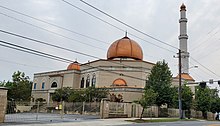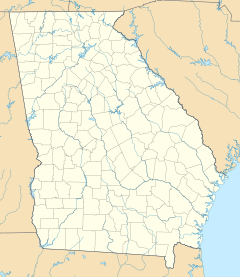A mosque, also called a masjid, is a place of worship for Muslims. The term usually refers to a covered building, but can be any place where Islamic prayers are performed, such as an outdoor courtyard.

The Temple Mount, also known as Haram al-Sharif, al-Aqsa Mosque compound, or simply al-Aqsa, and sometimes as Jerusalem's holyesplanade, is a hill in the Old City of Jerusalem that has been venerated as a holy site in Judaism, Christianity, and Islam for thousands of years.

The Aqsa Mosque, also known as the Qibli Mosque or Qibli Chapel, is the main congregational mosque or prayer hall in the Al-Aqsa mosque compound in the Old City of Jerusalem. In some sources the building is also named al-Masjid al-Aqṣā, but this name primarily applies to the whole compound in which the building sits, which is itself also known as "Al-Aqsa Mosque". The wider compound is known as Al-Aqsa or Al-Aqsa mosque compound, also known as al-Ḥaram al-Sharīf.
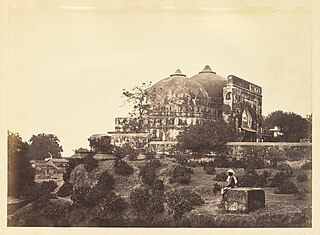
Babri Masjid was a mosque in Ayodhya, India. It has been claimed to have been built upon the site of Ram Janmabhoomi, the legendary birthplace of Rama, a principal deity of Hinduism. It has been a focus of dispute between the Hindu and Muslim communities since the 19th century. According to the mosque's inscriptions, it was built in 1528–29 by Mir Baqi, a commander of the Mughal emperor Babur. Before the 1940s, the masjid was officially known as "Masjid-i-Janmasthan". The mosque was attacked and demolished by a Hindu nationalist mob in 1992, which ignited communal violence across the Indian subcontinent.

The Prophet's Mosque is the second mosque built by the Islamic prophet Muhammad in Medina, after that of Quba, as well as the second largest mosque and holiest site in Islam, after the Masjid al-Haram in Mecca, in the Saudi region of the Hejaz. The mosque is located at the heart of Medina, and is a major site of pilgrimage that falls under the purview of the Custodian of the Two Holy Mosques.
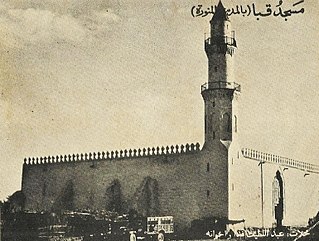
The Quba Mosque is a mosque located in Medina, in the Hejazi region of Saudi Arabia, built in the lifetime of the Islamic prophet Muhammad in the 7th century C.E. It is thought to be the first mosque in the world, built on the first day of Muhammad's emigration to Medina. Its first stone is said to have been laid by the prophet, and the structure completed by his companions.

Masjid-i-Jehan-Numa, commonly known as the Jama Masjid of Delhi, is one of the largest mosques in India.
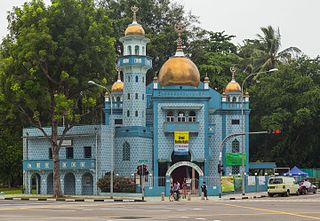
Masjid Malabar or Malabar Muslim Jama-Ath Mosque, also known as Golden Dome Mosque; is Singapore's only Malabar Muslim mosque. The mosque is located at the junction of Victoria Street and Jalan Sultan in the Kampong Glam district, in the Rochor Planning Area within the Central Area. The mosque is built on the Sultan Mosque style with traditional blue and white lapis lazuli tile facade. The mosque was nicknamed as little cousin of the Sultan Mosque, because of similar golden domes.

The holiest sites in Islam are predominantly located in the Arabian Peninsula and the Levant. While the significance of most places typically varies depending on the Islamic sect, there is a consensus across all mainstream branches of the religion that affirms three cities as having the highest degree of holiness, in descending order: Mecca, Medina, and Jerusalem. Mecca's Al-Masjid al-Haram, Al-Masjid an-Nabawi in Medina and Al-Masjid al-Aqsa in Jerusalem are all revered by Muslims as sites of great importance.
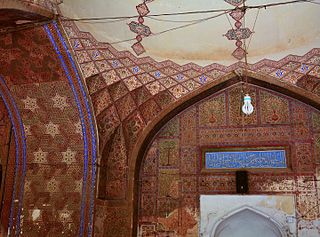
Begum Shahi Mosque, officially The Mosque ofMariyam Zamani Begum, is an early 17th-century mosque situated in the Walled City of Lahore, Punjab, Pakistan. Constructed by Mughal Empress Mariam-uz-Zamani, chief consort of Emperor Akbar, it is one of the largest mosques in Pakistan. The mosque was built between 1611 and 1614 during the reign of Mughal Emperor Jahangir.
Religion in Atlanta, while historically centered on Protestant Christianity, now involves many faiths as a result of the city and metro area's increasingly international population. While Protestant Christianity still maintains a strong presence in the city, in recent decades Catholic Christians have gained a strong foothold due to migration patterns. Atlanta also has a considerable number of ethnic Christian congregations, such as Korean Baptist, Methodist, and Presbyterian Churches, the Tamil Church Atlanta, Telugu Church, Hindi Church, Malayalam Church, Ethiopian, Chinese, and many more traditional ethnic religious groups. Large non-Christian faiths are present in the form of Buddhism, Judaism and Hinduism. Overall, there are over 1,000 places of worship within Atlanta.

Both Sunni Muslims and Shia Muslims agree on the three Holiest sites in Islam being, respectively, the Masjid al-Haram, in Mecca; the Al-Masjid an-Nabawi, in Medina; and Al-Masjid al-Aqsa, in Jerusalem.

Lists of mosques cover mosques, places of worship for Muslims. The lists include the most famous, largest and oldest mosques, and mosques mentioned in the Quran, as well as lists of mosques in each region and country of the world. The major regions, Africa, Americas, Asia, Europe and Oceania are sorted alphabetically. The sub-regions, such as Northeast and Northwest Africa in Africa, and Arabia and South Asia in Asia, are sorted by the dates in which their first mosques were reportedly established, more or less, barring those that are mentioned by name in the Quran.

The Islamization of Jerusalem refers to the process through which Jerusalem and its Old City acquired an Islamic character and, eventually, a significant Muslim presence. The foundation for Jerusalem's Islamization was laid by the Muslim conquest of the Levant, and began shortly after the city was besieged and captured in 638 CE by the Rashidun Caliphate under Umar ibn al-Khattab, the second Rashidun caliph. The second wave of Islamization occurred after the fall of the Kingdom of Jerusalem, a Christian state that was established after the First Crusade, at the Battle of Hattin in 1187. The eventual fall of the Crusader states by 1291 led to a period of almost-uninterrupted Muslim rule that lasted for seven centuries, and a dominant Islamic culture was consolidated in the region during the Ayyubid, Mamluk and early Ottoman periods. Beginning in the late Ottoman era, Jerusalem’s demographics turned increasingly multicultural, and regained a Jewish-majority character during the late-19th and early-20th centuries that had not been seen since the Roman period, which largely ended the Jewish presence in the region.
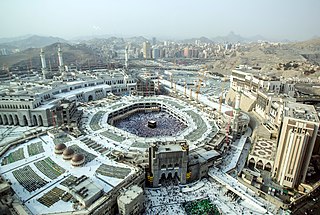
Masjid al-Haram, also known as the Sacred Mosque or the Great Mosque of Mecca, is a mosque enclosing the vicinity of the Kaaba in Mecca, in the Mecca Province of Saudi Arabia. It is among the pilgrimage sites associated with the Hajj, which every Muslim must perform at least once in their lives if able. It is also the main site for the performance of ʿUmrah, the lesser pilgrimage that can be undertaken any time of the year. The rites of both pilgrimages include circumambulating the Kaaba within the mosque. The Great Mosque includes other important significant sites, such as the Black Stone, the Zamzam Well, Maqam Ibrahim, and the hills of Safa and Marwa.
The following is a timeline of the history of the city of Atlanta, Georgia, United States.

The Qassabtuly Mosque is one of the most ornate mosques in Old Dhaka, Bangladesh. It's gloriously inscribed decorations are delicate and one of a kind.

Al-Azhar Great Mosque is a mosque located in Jalan Sisingamangaraja, Kebayoran Baru, Jakarta. The mosque was constructed between 1953 and 1958. It was originally known simply as Mesjid Agung. It was Jakarta's largest mosque when it was built until it was surpassed by the Istiqlal Mosque which was completed in 1978. Al-Azhar mosque and the mosque complex is best known for its educational works.
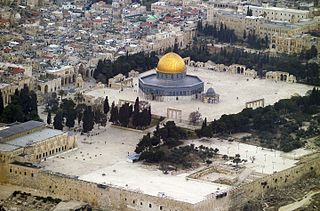
Al-Aqsa or al-Masjid al-Aqṣā is the compound of Islamic religious buildings that sit atop the Temple Mount, also known as the Haram al-Sharif, in the Old City of Jerusalem, including the Dome of the Rock, many mosques and prayer halls, madrasas, zawiyas, khalwas and other domes and religious structures, as well as the four encircling minarets. It is considered the third holiest site in Islam. The compound's main congregational mosque or prayer hall is variously known as Al-Aqsa Mosque, Qibli Mosque or al-Jāmiʿ al-Aqṣā, while in some sources it is also known as al-Masjid al-Aqṣā; the wider compound is sometimes known as Al-Aqsa mosque compound in order to avoid confusion.
